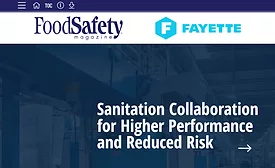Home » Keywords: » cleaning
Items Tagged with 'cleaning'
ARTICLES
Simplifying Sanitation Standard Operating Procedures
Cleaning/sanitizing SOPs should not be integrated to the "regulatory" requirements of SSOPs, but instead maintained as a separate set of documents
December 12, 2023
BIZTRACKS
Sanitation Solutions Supplier Goodway Technologies Opens Office in Europe
November 29, 2022
Choosing the right cleaning tools
Identify needs to ensure right cleaning and sanitizing equipment, materials choice
December 22, 2020
Tech | Supplier's Perspective
Is cleaning, sanitizing enough to establish 'sanitary' conditions?
December 18, 2020
Never miss the latest news and trends driving the food safety industry
Newsletters | Website | eMagazine
JOIN TODAY!Copyright ©2026. All Rights Reserved BNP Media.
Design, CMS, Hosting & Web Development :: ePublishing












